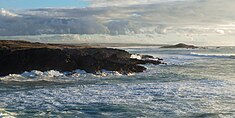Pessegueiro Island
| Pessegueiro Island (Ilha Pessegueiro) | |
| Island (Ilha) | |
|
The island of Pessegueiro as seen from the village of Porto Covo, during a winter storm
|
|
| Official name: Ilha do Pessegueiro | |
| Name origin: pessegueiro, Portuguese word for peachtree; literally "island of the peachtree" | |
| Country | |
|---|---|
| Region | Alentejo |
| Subregion | Alentejo Litoral |
| Location | Vicentine Coast, Atlantic Ocean |
| Municipality | Sines |
| Civil parishes | Porto Covo |
| Landmark | Fort of Pessegueiro Island |
| Highest point | |
| - elevation | 21 m (69 ft) |
| - coordinates | 37°50′0.57″N 8°47′51.22″W / 37.8334917°N 8.7975611°W |
| Lowest point | Sea level |
| - location | Atlantic Ocean |
| - elevation | 0 m (0 ft) |
| Length | .20 km (0 mi), West-East |
| Width | .32 km (0 mi), North-South |
| Biomes | Temperate, Mediterranean |
| Geology | Alkali basalt, Tephra, Trachyte, Trachybasalt |
| Orogeny | Volcanism |
| Period | Holocene |
| Ethnic groups | Portuguese |
| Statistics from INE (2001); geographic detail from Instituto Geográfico Português (2010) | |
Pessegueiro Island (Portuguese: Ilha do Pessegueiro), literally island of the Peachtree, is a small island/islet located along the southwest coast of the civil parish of Porto Covo in the municipality of Sines. The island and the adjacent coast are part of Southwest Alentejo and Vicentine Coast Natural Park, but Pessegueiro island is also notable for the 15th-16th century fort located at its centre and Roman ruins along the coast.
Historically, the island was first occupied by the Carthaginians before the Second Punic War (218-202 BCE).
At the time of the Roman conquest of Hispania, the island hosted a small fish processing centre, as determined by archaeological excavations which discovered the remains of salt tanks along the southern coast.
To help defend against privateers, the natural anchorage was extended at the time of the Iberian Union with an artificial rock barrier connecting the island of Pessegueiro to the coastline. In 1590, construction began on the Fort of Pessegueiro Island, which came to occupy a dominant position on the island, with the purpose of providing military support to a on the mainland. Work on the project was halted in 1598 in order to construct the .
According to tradition, in the middle of the 18th century, Barbary pirates arriving on the island from Algeria and Morocco encountered a Christian hermit who was maintaining a chapel dedicated to the Virgin Mary. The pirates killed the monk, looted the chapel and threw her statue into the flames.
Later the inhabitants of Porto Covo buried the Christian hermit, but could not, at first, find the sacred image. Deciding to search the entire island, they finally found the statue within a burned bush but unharmed by the fire: the image became known as the Queimada (Burnt Virgin). The statue was removed to the mainland, one kilometre from the island, where a new chapel was built, known as the Chapel of the Burned Virgin (Portuguese: Capela de Nossa Senhora da Queimada), becoming a destination for pilgrimages.
...
Wikipedia

